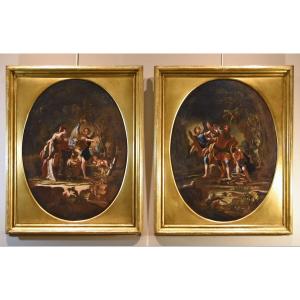Roman school of bamboccianti (mid-17th century) - workshop of Michelangelo Cerquozzi (Rome 1602 - Rome 1660)
Oil on canvas
74 x 96 cm. - Framed 88 x 110 cm.
Full details of the work (click HERE)
Set in a large square crowded with people in masks and costumes, the painting depicts a jubilant scene during the 17th-century Carnival of Rome, and is therefore a very interesting record of the customs of the time.
The painting is set in Piazza Colonna, with a fragment of the famous column of Marcus Aurelius, entirely decorated with bas-reliefs, and surrounded by some of the most important historical buildings in Rome, in particular Palazzo Ferrajoli and Palazzo Chigi.
A city event with ancient origins - inspired by the Saturnalia of the ancient Romans, in which slaves were elevated to the rank of masters, subverting the ordinary social order - the Carnival, starting from the 16th century, became one of the main celebrations of papal Rome, and one of the richest and most unbridled in Europe, and during the Renaissance it became more popular and renowned than the Venetian one.
It wasn't just a celebration but an integral part of the city's culture: as in ancient times, the Roman oligarchies allowed the population, especially the lower classes, a period dedicated to fun. The entire citizenry participated, the poor mingled with the powerful, being able to publicly mock them, protected by the anonymity of the masks: a sort of levelling of all social divisions was achieved and even the public derision of the authorities and the aristocracy was authorised.
People in masks paraded, disguised as the main characters of the Commedia dell'Arte, especially in the Roman style.
And so Via Lata (now Via del Corso), Piazza Colonna and Piazza Venezia became the places dedicated to the unfolding of the festival, allowing the people (and also the masked gentlemen) to take possession of the officiality of the festival.
Among the various painters who depicted carnival scenes, a special place is reserved for the Roman Michelangelo Cerquozzi (Rome 1602 - 1660), whose workshop we can easily trace the origins of our work to.
Active mainly in Rome, Cerquozzi became known for his affiliation with the Roman Caravaggisti movement - known as the ‘Bamboccianti school’ - a pictorial movement to which Flemish, Dutch and Italian painters adhered, favouring simple themes with popular scenes drawn from the daily life of Rome at the time.
And the Carnival, which lent itself perfectly to a narrative iconography of the common people, was therefore a typical subject of the ‘bambocciata’: in Cerquozzi's production there are several works with a carnival theme, preserved in various museums and collections, as well as many other authors belonging to the current, such as Jan Miel (see Carnival in Rome, 1653, Madrid Museo del Prado), Johannes Lingelbach (see Carnival in Rome, 1650/1651 Kunsthistorisches Museum).
ADDITIONAL INFORMATION:
The painting is sold complete with a beautiful antique frame and is accompanied by a certificate of authenticity and an iconographic description.
We organise and take care of the shipping of the purchased works, both in Italy and abroad, through professional and insured carriers.
If you would like to see this or any other work in person, we would be delighted to welcome you to our new gallery in Riva del Garda, at 18 Viale Giuseppe Canella. We look forward to seeing you!
Please contact us for any information or to arrange a visit. We will be happy to help.
You can also follow us on:
https://www.instagram.com/galleriacastelbarco/?hl=it
https://www.facebook.com/galleriacastelbarco/


















































 Le Magazine de PROANTIC
Le Magazine de PROANTIC TRÉSORS Magazine
TRÉSORS Magazine Rivista Artiquariato
Rivista Artiquariato